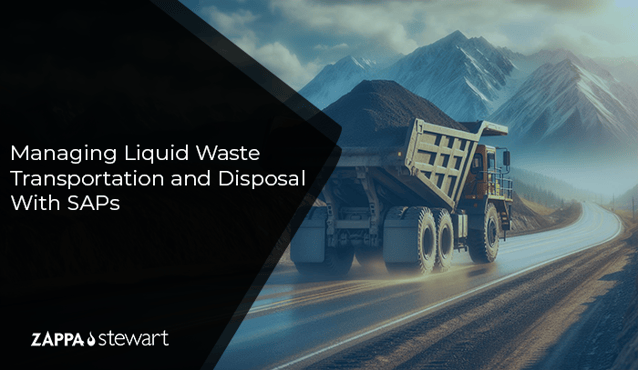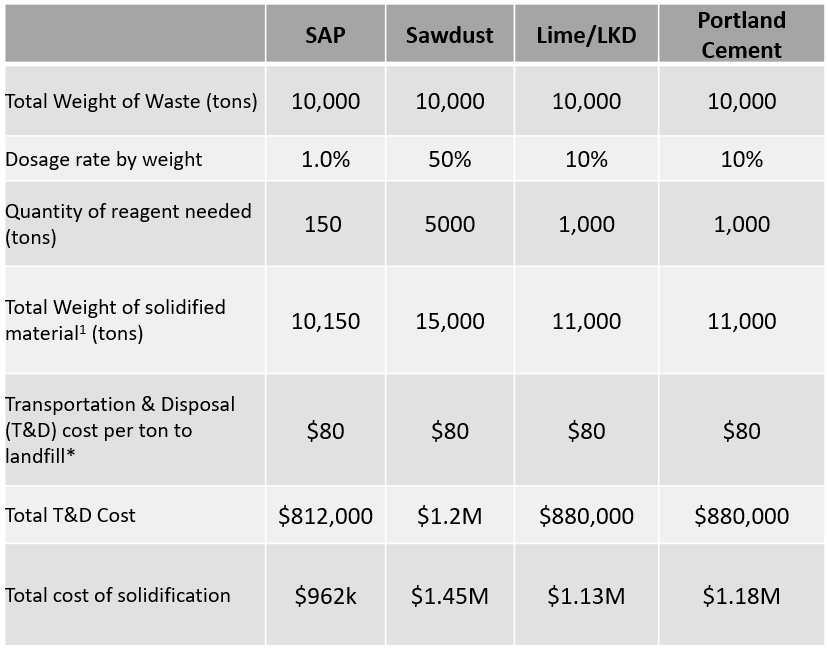
Liquid waste presents several challenges for many industrial processes. Liquids are difficult to transport, liquids contaminate work areas and environmental receptors, and most landfills do not accept liquids. On-site solidification with superabsorbent polymers (SAPs) offers the most rapid, safest, and, in most cases, most cost-efficient method for transforming difficult-to-manage liquid wastes into easily managed solid waste.
Liquid waste is defined as any waste that contains free liquids, as determined by the paint filter test (EPA Method 9095B). Free liquids are liquids that separate from the solid portion of a waste material, including:
- HDD mud and cuttings
- Landfill leachate
- Wastewater treatment sludge & biosolids
- Dredged sediments
- Oil and gas drill cuttings
- Settling pond muck
- Hydro Excavation slurry
- Coal combustion residuals (CCR, coal ash)
- Tank bottom sludge
- Concrete grinding/polishing slurry
Removal of liquid waste and transportation away from a site is usually accomplished with one of three general methods: Gravity draining & evaporation, vacuum extraction, or on-site solidification. Gravity draining & evaporation require space and time, rarely a luxury at industrial sites. Speaking of luxuries, vacuum extraction can range from $400-$600 per hour, or for a 3-hour trip just once per day, a total of $6,000-$9,000 per week. That leaves on-site solidification.
Rapid Liquid Waste Solidification with SAPs
SAPs can be easily applied to a waste pit or lagoon, a roll-off box, or blended via pug mill at the lowest dosage rates of any commercially available solidification reagent (approximately 0.25%-1.5% in most situations). SAPs react with liquid water (i.e. sludge pore water) instantaneously, allowing a track-hoe to fully solidify a 20-cubic yard rolled-off box of liquid waste streams into dry, stackable, soil-like material within 20-30 minutes or less.
Safety
When evaluating the safety factor of a solidification media, both for human contact and environmental impacts, SAPs hold the advantage over other available drying agents. SAPs used in the environmental sector are industrial variants of materials that are used for human personal hygiene products – products that involve intimate tissue contact. Therefore SAPs are rigorously tested for non-toxicity. Cement, LKD, fly ash, and lime are risky for use at project sites due to their corrosiveness to skin, eyes, the respiratory tract, and equipment as well as dusting concerns and potential contamination (heavy metals and radioactivity).
In contrast to cheap bulking agents such as sawdust, corn cobs, and fluff pulp, which release liquid under essentially any level of pressure or vibration, SAPs chemically retain the liquid in a rigid gel matrix within the dried waste even under moderate pressures found in landfills and when subjected to the vibrations in the bed of a dump truck. Superior liquid retention allows SAPs to remain in solid throughout the transit to the disposal facility and even after landfill placement, protecting environmental receptors from accidental leaks, spills, and seepages from the landfill cell.
Cost Efficiency
Due to the absorption capacity of SAPs, which are far and away the highest of any known absorbent product (think 30x-75x greater), only very small dosage rates of SAPs are required in most cases. Minimizing the dosage rates of solidification media minimizes the amount of material to be shipped to the site, staged on-site, blended into the waste, and hauled to the landfill. Each of these operations represents a significant cost savings opportunity during a liquid waste management project.

In conclusion, SAPs are the trusted on-site solidification media choice for industries such as dredging, remediation, HDD, mining, oil and gas exploration, wastewater treatment, and electric power generation due to SAPs superior solidification speed, safety, and cost efficiency.
For more information on how superabsorbent polymer technology can help you save your and your clients’ time, money, and risk; please contact Whit Rawls at wrawls@chasecorp.com.






